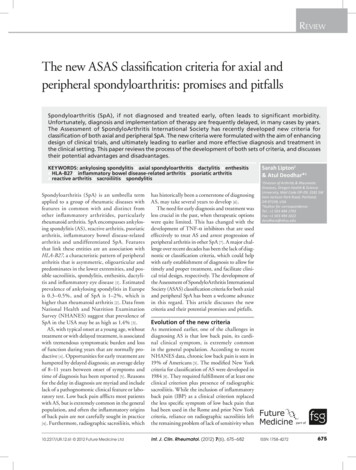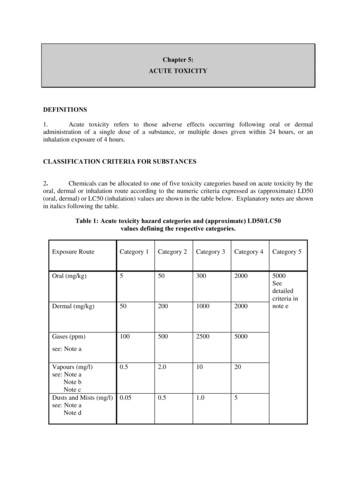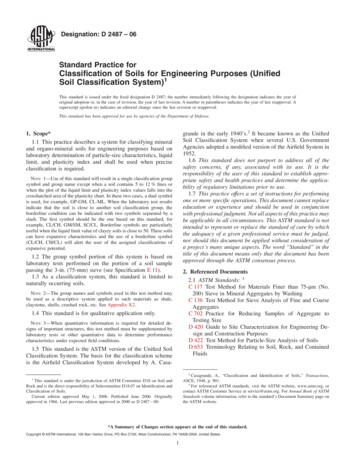
Transcription
ReviewThe new ASAS classification criteria for axial andperipheral spondyloarthritis: promises and pitfallsSpondyloarthritis (SpA), if not diagnosed and treated early, often leads to significant morbidity.Unfortunately, diagnosis and implementation of therapy are frequently delayed, in many cases by years.The Assessment of SpondyloArthritis International Society has recently developed new criteria forclassification of both axial and peripheral SpA. The new criteria were formulated with the aim of enhancingdesign of clinical trials, and ultimately leading to earlier and more effective diagnosis and treatment inthe clinical setting. This paper reviews the process of the development of both sets of criteria, and discussestheir potential advantages and disadvantages.Keywords: ankylosing spondylitis n axial spondyloarthritis n dactylitis n enthesitisn HLA-B27 n inflammatory bowel disease-related arthritis n psoriatic arthritisn reactive arthritis n sacroiliitis n spondylitisSpondyloarthritis (SpA) is an umbrella termapplied to a group of rheumatic diseases withfeatures in common with and distinct fromother inflammatory arthritides, particularlyrheumatoid arthritis. SpA encompasses ankylosing spondylitis (AS), reactive arthritis, psoriaticarthritis, inflammatory bowel disease-relatedarthritis and undifferentiated SpA. Featuresthat link these entities are an association withHLA-B27, a characteristic pattern of peripheralarthritis that is asymmetric, oligoarticular andpredominates in the lower extremities, and possible sacroiliitis, spondylitis, enthesitis, dactylitis and inflammatory eye disease [1] . Estimatedprevalence of ankylosing spondylitis in Europeis 0.3–0.5%, and of SpA is 1–2%, which ishigher than rheumatoid arthritis [2] . Data fromNational Health and Nutrition ExaminationSurvey (NHANES) suggest that prevalence ofSpA in the USA may be as high as 1.4% [3] .AS, with typical onset at a young age, withouttreatment or with delayed treatment, is associatedwith tremendous symptomatic burden and lossof function during years that are normally productive [4] . Opportunities for early treatment arehampered by delayed diagnosis; an average delayof 8–11 years between onset of symptoms andtime of diagnosis has been reported [5] . Reasonsfor the delay in diagnosis are myriad and includelack of a pathognomonic clinical feature or laboratory test. Low back pain afflicts most patientswith AS, but is extremely common in the generalpopulation, and often the inflammatory originsof back pain are not carefully sought in practice[4] . Furthermore, radiographic sacroiliitis, whichhas historically been a cornerstone of diagnosingAS, may take several years to develop [6] .The need for early diagnosis and treatment wasless crucial in the past, when therapeutic optionswere quite limited. This has changed with thedevelopment of TNF-α inhibitors that are usedeffectively to treat AS and arrest progression ofperipheral arthritis in other SpA [7] . A major challenge over recent decades has been the lack of diagnostic or classification criteria, which could helpwith early establishment of diagnosis to allow fortimely and proper treatment, and facilitate clinical trial design, respectively. The development ofthe Assessment of SpondyloArthritis InternationalSociety (ASAS) classification criteria for both axialand peripheral SpA has been a welcome advancein this regard. This article discusses the new criteria and their potential promises and pitfalls.Evolution of the new criteriaAs mentioned earlier, one of the challenges indiagnosing AS is that low back pain, its cardinal clinical symptom, is extremely commonin the general population. According to recentNHANES data, chronic low back pain is seen in19% of Americans [3] . The modified New Yorkcriteria for classification of AS were developed in1984 [8] . They required fulfillment of at least oneclinical criterion plus presence of radiographicsacroiliitis. While the inclusion of inflammatoryback pain (IBP) as a clinical criterion replacedthe less specific symptom of low back pain thathad been used in the Rome and prior New Yorkcriteria, reliance on radiographic sacroiliitis leftthe remaining problem of lack of sensitivity when10.2217/IJR.12.61 2012 Future Medicine LtdInt. J. Clin. Rheumatol. (2012) 7(6), 675–682Sarah Lipton1& Atul Deodhar*1Division of Arthritis & RheumaticDiseases, Oregon Health & ScienceUniversity, Mail Code OP-09, 3181 SWSam Jackson Park Road, Portland,OR 97239, USA*Author for correspondence:Tel.: 1 503 494 1793Fax: 1 503 494 1022deodhara@ohsu.edu1part ofISSN 1758-4272675
ReviewLipton & DeodharEuropean SpA Study Group classification criteria for SpAInflammatoryspinal painSynovitisAsymmetric predominant lower limbPlus one more of the following:– Alternate buttock pain– Sacroiliitis– Positive family history– Psoriasis– Inflammatory bowel disease– Urethritis or cervicitis or acute diarrhea occurringwithin 1 month before the onset of arthritisFigure 1. European Spondyloarthropathy Study Group criteria.SpA: Spondyloarthritis.applied to patients early in their disease course [9] .The Amor and European SpondyloarthropathyStudy Group (ESSG) criteria (Figure 1 & Table 1)were developed in the 1990s [10,11] .While the modified New York criteria solelyaddressed classification of AS, the Amor and theESSG criteria addressed the entire spectrum ofSpA, including undifferentiated disease, whichhad previously been ignored in many studies owing to lack of a workable definition. TheESSG criteria have ‘entry conditions’ in that theyrequire the presence of inflammatory spinal painor synovitis. The Amor criteria are a list of twelvevariables, with no mandatory features requiredfor classification. The Amor criteria performslightly better than ESSG in classification ofearly SpA, which may be attributable to the Amorinclusion of response to NSAIDs and HLA-B27typing [12] .The new ASAS classification criteriafor axial SpADevelopment of the new criteria (see Figure 2 )began with 20 experts in SpA (all ASAS members) reviewing clinical data of 71 real patientswho had presented to a rheumatology department in Berlin (Germany). The patients wereselected based on a history of chronic back painof unknown origin and a possible diagnosis ofSpA. Clinical data included gender, age, duration of back pain, clinical history, laboratorytests and imaging results, and were presented tothe experts in the format of ‘paper patients’. Interms of imaging, information about sacroiliitison plain radiographs was provided according tothe modified New York criteria. Additionally,all patients underwent sacroiliac joint MRI,and MRI findings were conveyed as presence orabsence of active inflammation [13] .Paper patients were first presented and classified without MRI information and candidatecriteria were formulated based on clinical reasoning, including review of imaging data. Oneof the interesting findings during the process ofdeveloping candidate criteria was the large proportion of patients (96%) who lacked definiteradiographic sacroiliitis and were hence considered to have nonradiographic axial SpA. In addition, MRI was found to play a substantial rolein classification. In 21% of patients, the experts’classification changed once MRI informationwas presented. It was also felt that the new criteriaTable 1. Spondyloarthropathies Amor Criteria 1990.Clinical characteristicScoreLumbar pain at night or lumbar morning stiffness1Asymmetric oligoarthritis2Buttock pain (or bilateral alternating buttock pain)1 (2)Sausage-like toe or digit(s)2Heel pain or other well-defined enthesities2Iritis2Nongonococcal urethritis/cervicitis within 1 month of onset1Acute diarrhea within 1 month of arthritis onset1Psoriasis, balanitis or inflammatory bowel disease (Crohn’s or ulcerative colitis)2Sacroiliitis (bilateral grade 2 or unilateral grade 3)2HLA-B27( ) or ( ) family history of a spondyloarthropathy2Rapid ( 48 h) response to NSAIDs2Diagnosis of a spondyloarthropathy requires a score of 6.Data taken with permission from [11].676Int. J. Clin. Rheumatol. (2012) 7(6)future science group
The new ASAS classification criteria for axial & peripheral spondyloarthritis: promises & pitfallsshould allow for classification based on clinicalcriteria alone, and the number and combinationof clinical features were selected based on a balance of sensitivity and specificity. Sets of candidate criteria were comprised mainly of positiveimaging plus one clinical feature, or IBP plus twoclinical features [13] .The candidate criteria were then validatedin an independent prospective internationalstudy of 649 patients from 25 centers. Inclusionrequirements were a history of chronic back pain(at least 3 months duration) of unknown etiology that began before 45 years of age, with orwithout peripheral symptoms. In an effort toprevent selection bias, patients were enrolled in astrictly consecutive matter. In addition to history,physical examination and laboratory testing thatincluded HLA-B27 and CRP, patients underwentplain radiographs of the pelvis. Sacroiliitis wasgraded for each sacroiliac joint separately (grades0–4). MRI of the sacroiliac joints was requiredin the first 20 patients in each center, while MRIof the spine was optional. MRI findings wererecorded as the presence or absence of activeinflammation, omitting chronic changes such aserosions and fatty degeneration [14] .Diagnosis by an expert physician (axial SpA orno SpA) was used as the gold standard. Followingdata analysis and presentation, the final criteriawere determined by vote of ASAS members. Thefinal criteria include an imaging arm and a clinical arm: by applying the final criteria, a patientwith chronic back pain of onset at before the ageof 45 years can be classified as having axial SpA ifthere is sacroiliitis on imaging (by radiographs orMRI) along with at least one other SpA feature,or if imaging evidence of sacroiliitis is absent, positive HLA-B27 along with at least two other SpAfeatures [14] . The new criteria performed well inthe validation study. Sensitivity was 82.9% andspecificity was 84.4%. The new criteria also outperformed the ESSG and Amor criteria, even afterincorporating ‘sacroiliitis on MRI’ into the earliercriteria [15] .Promises & pitfalls of the new axialSpA criteriaOne of the notable aspects of these criteria is theincorporation of the emerging concept of ‘nonradiographic’ axial SpA. This refers to patientswith signs and symptoms of axial disease who lackthe radiographic damage to the sacroiliac jointsto meet the modified New York criteria [16] . Thisentity may be part of the same spectrum of diseaseas AS (see Figure 3). Investigators of the GermanSpondyloarthritis Inception Cohort (GESPIC)future science groupReviewThe Assessment of SpondyloArthritis International Societyclassification criteria for axial SpA(in patients with back pain 3 months and age at onset 45 yearsSacroiliitis on imaging†plus 1 SpA feature‡orHLA-B27plus 2 other SpA features‡Figure 2. Axial spondyloarthritis classification criteria.†Active (acute) inflammation on MRI, highly suggestive of sacroiliitis associated withSpA or definite radiographic sacroiliitis according to the modified New York criteria.‡Inflammatory back pain, arthiritis, enthesitis (head), uveitis, dactylitis, psoriasis,Crohn’s disease (ulcerative colitis), good response to NSAIDs, family history of SpA,HLA-B27 and elevated CRP.SpA: Spondyloarthritis.Data taken with permission from [14] .sought to prospectively study the disease courseof patients with early axial SpA and identifypredictors of outcome. They compared patientswith established early AS and patients with nonradiographic SpA (the latter diagnosis had to bedetermined by the treating rheumatologist, andwas carried out prior to the publication of thenew criteria). Clinical manifestations, presenceof HLA-B27 and levels of disease activity werefound to be quite similar between the groups [17] .The inclusion of MRI, given equal weight asradiographic sacroiliitis, in the criteria is a crucial advancement. Advantages of MRI includemultiplanar imaging, absence of ionizing radiation and superior tissue contrast resolution[18] . MRI is highly sensitive for detection ofsacroiliitis, mainly via demonstration of bonemarrow edema representing early stages ofinflammation. This is usually best seen on fatsuppressed T2-weighted or short tau inversionrecovery (STIR) sequences, by which increasedwater content (representing cellular infiltrationor replacement of bone marrow fat) heightenssignal intensity. Alternative techniques requiring contrast agents include fat-suppressedT1-weighted images following the gadoliniumadministration, with heightened signal intensity representing changes in tissue perfusion.Potential disadvantages of contrast administration, however, include cost, requirement ofintravenous access and potential risk of nephrogenic systemic fibrosis [16] . The ability to detectsacroiliitis by MRI during early stages of disease,well before detection by radiographs is possible,has been demonstrated [19] . Furthermore, onestudy demonstrated the utility of bone marrowedema surrounding the sacroiliac joints on MRIin predicting subsequent development of AS [20] .The definition of a positive MRI, or ‘active sacroiliitis by MRI’, applied in the new criteria wasdetermined by consensus by rheumatologists andwww.futuremedicine.com677
ReviewLipton & DeodharPreradiographic stage(undifferentiated axial SpA)Back pain(MRI: active sacroiliitis)Radiographic stage(ankylosing spondylitis)Back painRadiographicsacroiliitisBack painSyndesmophytesTime (years)Figure 3. Spectrum from spondyloarthritis to ankylosing spondylitis.Data taken with permission from [9] .SpA: Spondyloarthritis.radiologists comprising the ASAS/OMERACTtrials MRI working group. Among the activeinflammatory lesions detectable by MRI, the clearpresence of either bone marrow edema on STIRor osteitis on T1 postgadolinium imaging wasdeemed a requirement in defining active sacroiliitis. The presence of structural lesions (such as fatdeposition, sclerosis, erosions and bony ankylosis),while likely to reflect previous inflammation, werenot felt to sufficiently define a positive MRI inthe absence of bone marrow edema or osteitis [21] .The superior sensitivity of MRI was supported inthe evaluation of the ASAS ‘paper patients’. Only2.8% of patients had definite sacroiliitis according to the modified New York criteria, but 38%of them were found to have sacroiliitis on MRI[13] . It should be noted, however, that bone marrow edema of the sacroiliac joints is not perfectlyspecific for inflammation, as it can be present inother settings that include mechanical stress [21] .Thus, inappropriate use of the sacroiliac jointMRI in a young patients with chronic back painof mechanical origin has a danger of misdiagnosis. Another potential limitation of the criteria isthe exclusion of spinal MRI, which could haveimproved sensitivity as well as specificity [20] .Ability to classify someone with nonradiographic axial SpA, even in the absence of positiveMRI, using the ‘clinical arm’ (i.e., positive HLAB27 with at least two SpA features) is one of theadvantages of the new axial SpA criteria. However,since the prevalence of HLA-B27 amongst whiteCaucasians within the USA is known to be 7.5%,some people could get misclassified if they havesoft signs/symptoms of SpA along with positiveHLA-B27 by chance. This misclassification wouldincrease if the person comes from an ethnic groupthat has an even higher prevalence of HLA-B27(such as some Native American populations). Thispitfall should be kept in mind when classifyingpeople using the ‘clinical arm’ of the criteria.678Int. J. Clin. Rheumatol. (2012) 7(6)The axial SpA criteria and definition of apositive MRI were studied in an inceptioncohort comparing patients with IBP to controlpatients. All of the patients with IBP were classified as having axial SpA, with more patientsmeeting the imaging arm of the criteria thanthe HLA-B27 arm (83 vs 62%, respectively).Both arms showed good diagnostic utility butwere less valuable for prediction of radiographicprogression. This might be due to limited specificity of the ASAS definition of a positive MRIat baseline, or it may be that MRI evidence ofsacroiliitis may not truly be a good prognosticmarker. Prognostic utility may also be limitedby inclusion of mild bone marrow edema in thedefinition of a positive MRI, and a role for additional prognostic factors independent of MRIfindings [22] .As discussed above, the disease burden of nonradiographic SpA is quite similar to that of AS.It is, therefore, imperative to establish a modeof early and effective diagnosis and treatmentof this entity. The new criteria are expectedto enhance design of future clinical trials andobservational studies [23] . This may have directtherapeutic implications, supported by evidenceof efficacy of anti-TNF agents in patients withnonradiographic SpA [24,25] . While designed forclassification and not diagnostic purposes, thecriteria may have a role in diagnosis in the setting of a rheumatology clinic. When they wereapplied in this setting to patients with undiagnosed back pain, pretest probability of axial SpAof 60% increased to a post-test probability of89%, with a positive l ikelihood ratio of 5.3 [14] .Caution must be exercised, however, in theextrapolation of classification criteria to theclinic. While the diagnostic performance of thenew criteria in the outpatient rheumatology clinicwas good, it was not perfect. Fulfillment of classification criteria, which work well in the study ofgroups of patients, does not necessarily translatedirectly to a diagnosis in an individual patient[26] . As noted above, one other aspect of delayin diagnosis that remains a challenge is facilitating referral to the rheumatologist of appropriatepatients with back pain and a high pretest probability of axial SpA. It is not yet clear whether thecriteria could have utility in such ‘referral clinic’settings, and while this remains unansweredthere is risk of misuse of them as diagnostic criteria [15] . This risk is pronounced when classification criteria are applied in a population witha low pretest probability of disease [9] and couldlead to inappropriate use of anti-TNF agents totreat patients with chronic mechanical back pain.future science group
The new ASAS classification criteria for axial & peripheral spondyloarthritis: promises & pitfallsThe new ASAS classification criteriafor peripheral SpAThe process of developing the new criteria forperipheral SpA (see Figure 4) was similar to thatfor axial SpA. Two sets of candidate criteriawere formulated based on clinical reasoning andthen tested in 35 ‘paper patients’, adjusted andvalidated. Patients without back pain and withperipheral manifestations that usually beganbefore the age of 45 years, but without an established diagnosis, were included. Two hundred andsixty six patients from 24 centers were recruited.Again, in an effort to minimize selection biaspatients were enrolled in a strictly consecutivemanner, and again clinical diagnosis (SpA orno SpA) by an ASAS rheumatologist was usedas the gold standard. A final set of criteria showing the best balance of sensitivity (77.8%) andspecificity (82.9%) was decided upon. It consists of peripheral arthritis (usually lower limbpredominant and asymmetric) and/or enthesitisand/or dactylitis) plus additional features. Theseadditional features may include one or more ofthe following: psoriasis, inflammatory bowel disease, preceding infection, HLA-B27, uveitis andsacroiliitis on imaging. Alternatively, they mayinclude two or more of the following: arthritis,enthesitis, dactylitis, history of previous IBP andfamily history of SpA [27] .These new criteria, akin to the criteria foraxial SpA, performed better than versions of theAmor and ESSG criteria (which were modifiedto include MRI findings), particularly in termsof sensitivity [27] . Additionally, a combination ofthe new criteria for axial and peripheral SpA wascompared to the modified versions of the Amorand ESSG criteria in the entire ASAS population of 975 patients. The balance of sensitivityand specificity of the combined new criteria wasfound to be superior to both of the older criteriasets. These figures for the combined new criteriawere sensitivity of 79.5% and specificity of 83.3%,compared with 79.1 and 68.8%, respectively forthe modified ESSG criteria, and 67.5 and 86.7%,respectively, for the modified Amor criteria [27] .Promises & pitfalls of the newperipheral SpA criteriaThe criteria for peripheral SpA call for a reorganization of inter-related diseases into groupsbased on clinical manifestations rather thanunderlying individual disease entities (seeFigure 5 ). To some experts, referred to as ‘lumpers’, this is appropriate because they considerdifferent SpA entities as variable expression ofthe major features of the same disease. Unifyingfuture science groupReviewfeatures invoked in support of this approachinclude association with HLA-B27, commonground in therapies employed and potentiallyshared pathogenic mechanisms. A genetic linkis suggested by findings that include a higherfrequency of psoriasis in patients with Crohn’sdisease than in controls [28] . It is hoped that thenew criteria will allow for clinical trials to examine diagnostic and therapeutic interventions ina defined clinical s ubgroup, regardless of theunderlying etiology [12] .One of the advantages of the new peripheral criteria is the inclusion of monoarthritisand polyarthritis in addition to oligoarthritis,leading to increased sensitivity of the criteria.Another advantage is that fewer clinical featuresare required to fulfill the new criteria. A notabledistinction between these and the ESSG criteria is that enthesitis and dactylitis are includedas entry criteria along with arthritis, so a patientwho presents with enthesitis and/or dactylitis butwithout arthritis could be classified. The additionof HLA-B27 is also considered an advantage, sinceall spondyloarthritides share association with thisgene [29] .On the other hand, ‘splitters’ assert that differences between the individual disease entities thatcan cause peripheral SpA are significant enoughto warrant separate consideration in classificationcriteria. They cite differences in clinical presentation, etiology and genetics that should be recognized. Another concern is that in the setting of atrial it may be challenging to interpret outcomemeasures that have been validated in one subsetof SpA but not others, and treatment responsesmay be misinterpreted [28] . Emerging data regarding treatment of individual entities may also beoverlooked by the criteria and not addressed inclinical trials. One example of this is the recentwork supporting combination antibiotics in themanagement of Chlamydia-induced reactiveArthritis or ethesitis or dactylitisPlus 1 of:– Psoriasis– Inflammatory bowel disease– Preceding infection– HLA-B27– Uveitis– Sacroiliitis on imaging(radiographs or MRI)orPlus 2 of the remaining:– Arthritis– Ethesitis– Dactylitis– Inflammatory back painin the past– Positive family history for SpAFigure 4. Peripheral spondyloarthritis classification criteria.SpA: Spondyloarthritis.Data taken with permission from [27] .www.futuremedicine.com679
ReviewLipton & DeodharSpASplit of the unified spondyloarthritides(classification of clinical osing spondylitisInter-related diseases lumped togetheras spondyloarthritides (unifiedclassification of individual opathy ofinflammatorybowel diseaseUndifferentiatedSpAJuvenileSpAFigure 5. Inter-relationship between the new split of spondyloarthritis according to the Assessment of SpondyloArthritisInternational Society classification criteria and the present family of disorders.SpA: Spondyloarthritis.Data taken with permission from [12] .arthritis [30] . Since the CASPAR criteria for theclassification of psoriatic arthritis (PsA) alreadyexist, it is unlikely that these new peripheral SpAcriteria would be used in clinical trials designedspecifically on PsA patients [31] .Another potential drawback is the exclusionof patients with disease initiation after the ageof 45 years, which is not uncommon in peripheral SpA. It also remains unclear what degree ofspinal involvement should allow for classificationof a patient with peripheral involvement, andsimilarly what degree of peripheral involvementis allowed in classification of axial SpA. One orboth sets of criteria may be fulfilled at differentpoints in disease course, and this could hamperthe consistency of classification in clinical trials[12] . The same cautions mentioned above regarding misuse of classification criteria, which havebeen validated in a group of patients, for diagnosisin an individual patient in inappropriate clinicalsettings (i.e., low pretest probability) also apply.ConclusionA major challenge obstructing the effective treatment of SpA has been delay in diagnosis. The newASAS classification criteria provide promise forincorporation of data into means of improvingand streamlining clinical trial design, which willhopefully lead toward earlier diagnosis and initiation of proper therapy for individual patients. Thecriteria for axial SpA incorporate the concept ofnonradiographic axial SpA and a role for MRI inevaluation of SpA. They perform favorably whencompared to the older Amor and ESSG criteria.The reorganization of peripheral SpA entities proposed by the new criteria is viewed by some as anadvance and by others as detrimental. Advances680Int. J. Clin. Rheumatol. (2012) 7(6)include the increased emphasis on enthesitis anddactylitis, and the inclusion of HLA-B27. Thedecision to not distinguish between individualentities may cause confusion in the interpretationof outcome measures and treatment responses,and may not include available data on specificentities. Concerns that apply to both sets of criteria include the potential misuse as diagnosticcriteria in individual patients with low pretestprobability of SpA. Possible overlap and changeover time between degrees of axial and pe ripheralinvolvement may also pose challenges.Future perspectiveOver the coming years work will likely focus onvalidating these criteria further and assessingtheir value in the setting of clinical trials. Goalsfor future study include further clarifying theentity of nonradiographic axial SpA and defining the role for MRI in the diagnosis, clinicalfollow-up and evaluating the prognosis of axialSpA. Further study and discussion will also continue surrounding what is the most apt schemefor categorizing the various forms of peripheralSpA, and how much overlap in therapy amongthe different entities should be considered appropriate. As clinical trial data emerge and outcomemeasures are analyzed the criteria may requirefurther refinement. Future work will also addressthe utility of these criteria when translated intovarious clinical settings and will help addresswhether they should play a role in diagnosis ofindividual patients. Overall, despite some concerns and potential limitations, they represent animportant step forward in the pursuit of effective methods of early diagnosis and of meaningfulclinical research in the area of SpA.future science group
The new ASAS classification criteria for axial & peripheral spondyloarthritis: promises & pitfallsFinancial & competing interests disclosureThe authors have no relevant affiliations or financialinvolvement with any organization or entity with a financial interest in or financial conflict with the subject matteror materials discussed in the manuscript. This includesReviewemployment, consultancies, honoraria, stock ownership oroptions, expert testimony, grants or patents received or pending, or royalties.No writing assistance was utilized in the production ofthis manuscript.Executive summarySpondyloarthritis Features linking this group of diseases include association with HLA-B27, peripheral arthritis that is typically asymmetric and lower limbpredominant, and possibly include sacroiliitis, spondylitis, enthesitis, dactylitis and inflammatory eye disease. Diagnosis, and hence the implementation of proper treatment, is often delayed by years. Radiographic sacroiliitis, historically the cornerstone of diagnosis, can take years between 5 and 10 years from the start of symptoms todevelop.New features of the Assessment of SpondyloArthritis International Society axial spondyloarthritis criteria The concept of nonradiographic axial spondyloarthritis. Recognition of a role of MRI in identification of sacroiliitis.New features of the Assessment of SpondyloArthritis International Society peripheral spondyloarthritis criteria Diseases grouped by clinical features rather than by individual disease entities. Inclusion of dactylitis and enthesitis as entry criteria. Inclusion of monoarthritis and polyarthritis in addition to oligoarthritis.Conclusion While the new criteria represent a step forward in many ways, there are some concerns that remain; further study is required toestablish their role in spondyloarthritis classification and diagnosis in an individual patient. These criteria appear to perform well when compared with older sets of criteria for spondyloarthritis, and it is hoped that they will beused to enhance the design of clinical trials. In most clinical settings, caution must be exercised when attempting to employ classification criteria as diagnostic tools.References8Papers of special note have been highlighted as:n of interestvan der Linden S, Valkenburg HA, Cats A.Arthritis Rheum. 27(4), 361–368 (1984).9Rudwaleit M, Khan MA, Sieper J.The challenge of diagnosis and classificationin early ankylosing spondylitis: do we neednew criteria? Arthritis Rheum. 52(4),1000–1008 (2005).1Sieper J, Rudwaleit M, Khan MA, Braun J.Concepts
676 Int. J. Clin. Rheumatol. (2012) 7(6) utue iene ou REVIEW Lipton eohar The new ASAS classification criteria for axial & peripheral spondyloarthritis: promises & pitfallsREVIEW applied to patients early in their disease course [9]. The Amor and European Spondyloarthropathy Study Group (ESSG) criteria (Figure 1 & Table 1) were developed in the 1990s [10,11].










